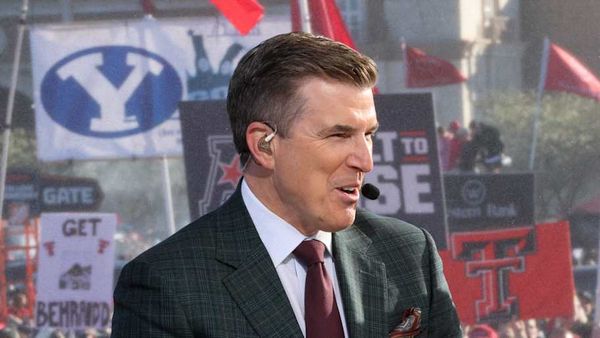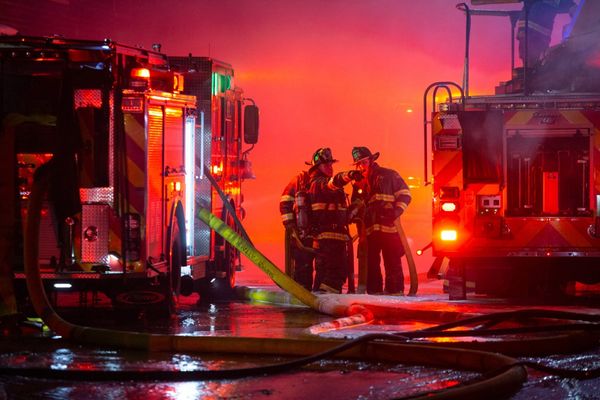At 5 o’clock in the morning, Boingoc Dinh awoke on a cool hospital floor and realised she wasn’t all right. It was the middle of 2020, the Covid-19 pandemic was raging across the world and Dinh, a second-year medical resident at WellSpan Good Samaritan Hospital in rural Pennsylvania, had cracked.
“My body was telling me something,” says Dinh, who had collapsed during a 12-hour night shift and regained consciousness two hours later. “I was pushed to my max. Absolute exhaustion.”
For Dinh, 31, the relentless demands of Covid-19 added to the intense pressures of an already gruelling early medical career. As the pandemic surged, it was pushing her and her colleagues to breaking point. “The longer the pandemic went on,” she says, “the more depression and anxiety I saw — in my colleagues, in my patients, everyone. The mental health toll was astronomical.”
As waves of patients flooded the wards, many destined for ventilators they would never be uncoupled from, Dinh struggled to fight a feeling of hopelessness. Her weight dropped to under six stone. Several of her colleagues quit the residency programme, and the cohort of newly qualified doctors were frequently working 80-hour weeks. One attempted suicide.
“It just does something to your soul, I don’t know how else to put it,” Dinh recalls. “Just day in, day out, seeing human suffering, and not being able to do anything about it.”
After her collapse, Dinh continued with her shift for another hour and a half, signed off her patients to the next resident at 6.30am and went home exhausted. She consulted two doctors and was signed off work for three months but — living alone with no work and no real social interaction — her mood deteriorated. She found herself in a trap that felt impossible to escape: with $260,000 of debt from her medical tuition, on top of her undergraduate loan, she knew she couldn’t afford to quit medicine, despite the damage it was doing to her mental health.
One summer night, feeling she had nowhere else to turn, she sent a one-line email that would change her life: “Please help me.”
The physical toll of the coronavirus pandemic has been headline news for more than a year, a gruesome daily tally of lives lost. But the waves of psychological illness, less visible, have been similarly catastrophic.
For the doctors and nurses on the front lines, the exposure has been uniquely acute, and researchers are racing to understand the impact of their experiences. Emerging research from countries including the UK, the US, China, India and Italy has shown alarmingly high rates of mental health disorders among front-line healthcare workers during the pandemic.
In February, a group of academics led by Talya Greene of the University of Haifa and Jo Billings of University College London published a paper in the European Journal of Psychotraumatology which found that, during the first wave of the pandemic, 22 per cent of all UK medical staff met the diagnostic criteria for post-traumatic stress disorder, 47 per cent for anxiety and the same number for depression.
Monica Durrette, a clinical psychologist in Virginia, says, “I have had physicians in tears during sessions, because they’re so exhausted, angry, frightened. And I’ve had people say, ‘This is breaking me, I just feel broken.’ It’s heart-wrenching.”
For many of these health workers, the bleak reality of their daily battle contrasts painfully with glowing narratives of heroism propagated in the media and local communities. It also illustrates a deeper crisis that long predates the pandemic, an undercurrent of burnout and mental illness plaguing a profession that should be uniquely placed to look after itself.
According to Gary Price, president of the Physicians Foundation, 300-400 doctors took their own lives every year in the US, even before the pandemic — the highest suicide rate of any profession. “That translates out at a conservative estimate to about one million patients losing their physician every year just to suicide,” Price says.
Meanwhile, more than 65 per cent of emergency doctors say they have experienced burnout during their careers, according to the American College of Emergency Physicians (ACEP). “We’re just seeing the tip of the iceberg right now,” says Bobby Chhabra, president of the University of Virginia Physicians Group. “We’re still in the midst of the pandemic — what’s going to happen as we get to the other side?”
In the mid-2000s, when soldiers began returning from the wars in Iraq and Afghanistan, the US Department of Veterans Affairs (VA) hired psychologists both to support the service personnel and to unpack the effects of their trauma.
In addition to the typical symptoms of post-traumatic stress disorder — such as nightmares, flashbacks and severe anxiety — researchers found that many of the veterans were wrestling with a deeper, more existential component, which they termed “moral injury”.
What plagued the soldiers was less the horror of what they’d seen on the battlefield than the horror of what they perceived themselves to have done. “Their pain was coming much more from the sense that they had violated values that were critical to their being,” says Sonya Norman, director of the National Center for PTSD’s consultation programme, who was hired by the VA at the time and was one of the first academics to study the phenomenon.
For doctors and nurses serving on the front lines of the pandemic, a similar combination of trauma effects seems to be at the root of soaring rates of mental distress. In addition to witnessing extraordinarily high volumes of death and suffering over the past year, many have been forced to make unprecedented ethical decisions that they would never have been faced with in normal practice, such as choosing which patient gets a ventilator and which doesn’t — creating an unease over the responsibility that comes with “playing God”.
“The bottom line is when you know what your patient needs and you can’t get it for them, because of some external structure that’s preventing you, that’s where the moral injury occurs,” says Wendy Dean, a former emergency room physician and psychiatrist who in 2018 co-founded the US non-profit Moral Injury of Healthcare.
Natalia Guzman-Seda, a resident anaesthesiologist at a teaching hospital in Brooklyn, says the case numbers during the first wave were so overwhelming that she and her colleagues barely had time to restock their supplies to keep up with the influx. At the peak of the first wave in early April 2020, New York City had more than 6,000 new cases a day.
“I would go to intubate a patient, and then go back to the [operating room] to restock, and then I would get another [call] and I would say, I feel like I’ve been here before,” she says. “And I realised that I’m intubating the neighbour of the patient that I had intubated earlier. And that one was already dead.”
As New York City’s case numbers started to climb again later that year, Guzman-Seda began experiencing panic attacks, as well as a paralysing sense of guilt about her actions during the first wave. “I would talk to my therapist about it, and I would tell them that I felt really guilty about Covid — how I managed it, how we managed it,” she says. “They would tell me, ‘Natalia, you didn’t do anything wrong at all.’ But it would feel wrong and I didn’t really understand why.”
In particular, she was fixated on the idea that she had assured patients she was intubating that they would be OK if they allowed her to insert the breathing tube into their airway - necessary for them to be placed on a ventilator - despite knowing that very few would survive. “I felt like, Who am I to take away hope from them?” she says. “But at the same time I feel very conflicted… I felt, in a way, I was lying to them.”
In February 1973, the American Medical Association published a landmark paper that reshaped the way the profession saw itself. The Sick Physician: Impairment by Psychiatric Disorders, including Alcoholism and Drug Dependence was the first major public acknowledgment of a taboo subject already widely known by those who worked in medicine: that doctors, popularly perceived as invulnerable, were struggling with mental illness at far higher rates than the general public. It cited one study showing “narcotic addiction in physicians varied from 30 to 100 times that found in the general population”.
The paper, which accused the medical profession of engaging in a “conspiracy of silence” over doctors’ mental health, spurred a wave of activity through the 1970s as hospitals across the US rushed to set up programmes dedicated to physicians’ wellbeing. Rates of drug and alcohol abuse among doctors appear to have declined since, but a 2015 study still found that 13 per cent of male doctors and 21 per cent of female doctors “met diagnostic criteria for alcohol abuse or dependence”; the rate of “alcohol use disorder” in the US’s general population in 2019 was 5.3 per cent.
The email Boingoc Dinh sent last summer was to Pamela Wible, a doctor and activist who has spent two decades campaigning for physician wellbeing after falling into a suicidal depression in 2004 when practising in Eugene, Oregon. Eight years later, she learnt that three doctors in the town had taken their own lives within the space of 18 months. “That’s when it hit me,” she says. “The lightbulb went off in my head, and that’s when I realised: Oh wow, this isn’t just me.”
Wible, who now runs weekly retreats for doctors struggling psychologically, attributes much of the current crisis in the US to the growing financial pressure on its healthcare system. “Essentially, we’ve taken a noble, beautiful profession that could be quite fulfilling, and we’ve turned it into factory work,” she says. “We’ve gone from relationship-driven medicine into production-driven medicine.”
According to Laura Wooster, associate executive director of public affairs at ACEP, years of stagnant reimbursements from the Medicare federal insurance programme, coupled with onerous demands from private insurers, have forced hospitals to curtail the time doctors spend with patients. “We think of it as the ‘seven-minute visit’,” she says. “You can’t spend the time you need with [your patients] to practise medicine in the way you trained to.”
In the UK, though the healthcare system is nationalised, a decade of austerity has resulted in similar pressures on doctors and nurses — which are exacerbated in both countries by ageing populations, growing bureaucracy and the inherently tough nature of the job. “The issues that we had before the pandemic have not gone away,” says Andrew Goddard, president of the Royal College of Physicians. “The NHS was really understaffed, both in the medical and nursing workforce. It was getting busier and busier… and we were dealing with patients that were older and frailer. So it was crumbling before we started.”
Doctors who are struggling with their mental health often find themselves in a vicious bind: in a culture of stoicism that stigmatises weakness, they can be reluctant to seek help, particularly when it requires them to consult with colleagues. But without any intervention, their condition often deteriorates, increasing the likelihood of professional errors that can further erode their mental state.
According to a recent poll from the American College of Emergency Physicians, 45 per cent of emergency doctors in the US say they do not feel comfortable seeking mental health treatment. As Dinh says, “Medicine does not foster a culture where you can talk about your weaknesses or your vulnerabilities, because, as physicians, we’re supposed to be pillars of society, or strength, where we can just endure anything.”
In the US, the stigma is formalised in legislation that requires doctors to declare any previous mental health problems when they apply for a medical licence in half of the nation’s states. The result is that physicians often refuse to admit to any psychological distress for fear it may jeopardise their ability to practise.
DJ Polzin, a medical resident based in Arizona, wrote off his car in May 2020 after driving through a red light while suffering from severe anxiety from working during the pandemic. “I was just so stressed out,” he says. “I was looking straight ahead, I didn’t even see the light change.”
After the accident, Polzin felt he needed psychological support, but he didn’t sign up to services offered by his residency programme in part because of fear of marking his record. Instead he spent six months trying to help himself by listening to cognitive behavioural therapy podcasts, before eventually finding an online counsellor. “If somebody says, ‘Hey, we’re gonna pull the plug on training you,’ then it’s almost impossible for you to finish,” he says, “and at that point you would have spent hundreds of thousands of dollars and years of your life.” Today, Polzin says he is feeling much better and is in “a good place”.
For more senior doctors, whose salaries are high enough to relieve them of the burden of student debt, the risk of attrition is also growing. According to a recent survey from the British Medical Association, 27 per cent of doctors said they were more likely to take early retirement since the pandemic began. Wendy Dean says that the mood is similar in the US: “A lot of them fantasise about leaving all the time. The difference I’ve heard [recently] is: ‘I am making plans. I’m shopping for farms; I’m looking at industry; I am applying for fast-food franchises.’ People are serious.”
If there is something positive to be taken from the pandemic, it may be that it has finally forced a reckoning over the mental health crisis in medicine.
One of the highest-profile cases during the past year was that of Lorna Breen, a doctor from New York whose death by suicide in April 2020 triggered a wave of alarm in the medical community. Breen, who was 49 and medical director of the emergency department at New York-Presbyterian Allen Hospital, had no known mental health issues but began to spiral after working relentlessly on the front lines, which led to her contracting Covid-19 herself.
“What’s remarkable about this story was how fast it happened,” says Breen’s brother-in-law, Corey Feist, whose wife Jennifer arranged an emergency relay of friends to shuttle Lorna back to their hometown of Charlottesville, Virginia, when it became clear how badly she was suffering. “If you think about it, for a physician, this is what they trained for their whole career,” Feist says. “They ‘should’ be able to keep up.” But Breen never saw stepping away as an acceptable option.
Since Breen’s death, the couple have been at the forefront of the battle against physician suicide, creating the Dr Lorna Breen Heroes Foundation, , a non-profit which advocates for better mental health in the profession. Feist is adamant that what needs to change is the system, rather than doctors and nurses themselves. “This is not a question of trying to make the healthcare worker more resilient,” he says. “We have to get upstream of this problem.”
The revolution in how global health systems take care of their staff may still be some way off, but there are signs of progress. Once the coronavirus had swept through Wuhan in late 2019, bringing with it a pattern of psychological symptoms in medical workers that grimly echoed those of the Sars epidemic nearly two decades before, the Chinese government acted to intervene (albeit having pressured early whistleblowing doctors to keep quiet).
By February, hospitals in eastern China had set up emergency psychological intervention teams to stem the tide of anxiety, depression and insomnia, while the National Health Commission of China had published the country’s first ever national guidelines for the psychological protection of health workers, which called for the early identification of high-risk groups and the creation of psychological rescue teams.
In the US, the Biden administration has allocated $120m to support medical staff wellbeing as part of the Covid-19 relief bill, and in the UK, NHS England and NHS Improvement announced last October that they would invest £15m in psychological support for staff. Last month NHS England chief executive Sir Simon Stevens said that it was also creating 40 mental health hubs across the country to give advice to workers and direct those in need to specialised services.
Critics argue that such provisions are often too little, too late. “Everyone I’ve spoken to about [the new hubs] believes that it will not be enough — that they will get swamped,” says Andrew Molodynski, mental health lead at the British Medical Association.
Prerana Issar, chief people officer for the NHS, says: “The last year has been like no other for our staff and their response to caring for hundreds of thousands of patients has been truly extraordinary. It is absolutely right that staff are also well supported and cared for, which is why there is help and advice available... including a confidential advice line, 24/7 text support and access to mental health services.”
In some cases, hospitals have taken matters into their own hands. When the virus first hit the UK, Charlie Cole, a trainee psychologist at Homerton hospital in east London who had previously worked as part of a service for healthcare workers during the West African Ebola epidemic, created one of the country’s first psychological support services dedicated to staff. “My biggest learning point is that services like this should have existed way before,” says Cole. “We shouldn’t have waited until there was a pandemic.”
On a recent Tuesday afternoon, I attended one of Cole’s virtual wellness sessions for a dozen or so of Homerton’s community nurses. The nurses, whose work involves visiting patients at home rather than treating them on wards, are mostly first-timers, and take to expressing their feelings in public with some trepidation. “Kwame’s there!” says Beatrice Osuntoki, one of the community matrons, laughing and pointing to her colleague after silence follows one of Cole’s questions. “Come on, Kwame!”
Gradually, the group warms up, as Cole walks them through concepts such as moral injury and compassion fatigue. Delfor Lee, another community matron, recalls the emotional strain of going into homes to care for dying patients multiple times a week, all the while knowing that she risked bringing the virus home to her family, one of whom has a disability. “I’m capable and competent in looking after end-of-life patients,” she says. “It is just the stress that comes with it. And I think we are expected to shoulder everything and just march on.”
Some who use the service are directed towards more substantial treatment. After contacting Cole’s service in January, Alfred Batalla, a senior staff nurse in the intensive care unit at Homerton who began experiencing panic attacks and nightmares after the first wave, was referred to a psychiatrist. He was subsequently diagnosed with severe anxiety and PTSD, and encouraged to take time off.
“Normally, I’m that person — I cheer everyone up when I’m at work,” says Batalla, 32, from his flat in London, where he is wearing a T-shirt emblazoned with the NHS logo. “What helped me was she said, ‘I’m giving you permission to drop everything and take care of yourself.’” When we speak, he has just been back to the intensive care unit to catch up with colleagues after four weeks’ rest at home. “Now, when I think about work, I miss [it],” he says.
For Batalla and the Homerton community nurses, there is at least one bright spot on the horizon: the vaccine rollout and the UK’s roadmap out of lockdown. “Hurry up, I can’t wait!” says Denise Francis, a district nurse team leader, during the wellness group. “I’m going home to Jamaica!”
When I catch up with Boingoc this month, she has just arrived at her parents’ house in Houston, Texas, after driving 1,600 miles across the country. She has resolved to begin a new life.
A few weeks earlier, she quit her gruelling residency programme, deciding — after regular counselling with Pamela Wible — to protect her health, regardless of the professional risks. “Pamela was like, ‘You don’t need the system. The system needs you. And you can do whatever you want with your precious life — just know that you have one.’”
For now, she plans to stay in Houston and take time to heal with her family, where she says she’s been akin to an “absent business dad” through years of all-consuming training. “I’ll spend some time here and after I feel good enough and the weather starts to warm up, I think a road trip to the national parks would be really nice,” she says.
Eventually, she plans to start a private clinic in Oregon, specialising in the field she discovered during the pandemic was most meaningful to her: trauma. “A lot of times, when people know they’re about to die, they tell you about their life story and their regrets, and the things that they’ve had to endure,” she says. “What I’ve discovered is there’s a lot of people out there who are suffering greatly from trauma, and they just bury it inside.”
India Ross is an FT editor
Follow on Twitter to find out about our latest stories first.
Copyright The Financial Times Limited 2021
2021 The Financial Times Ltd. All rights reserved. Please do not copy and paste FT articles and redistribute by email or post to the web.







